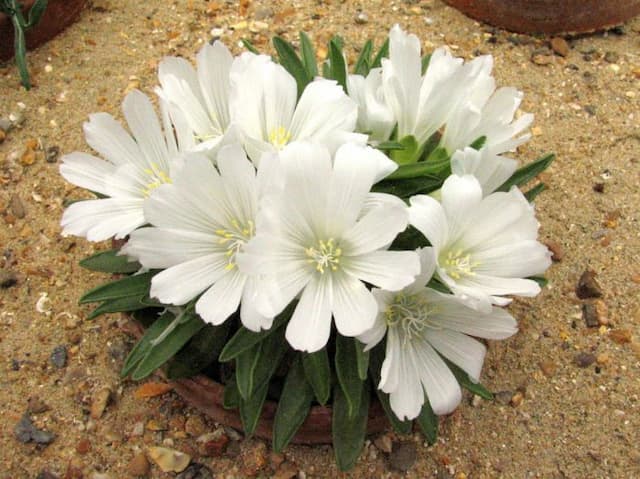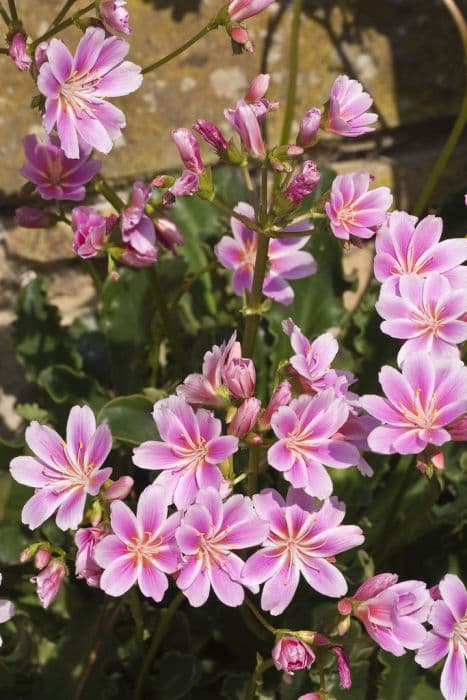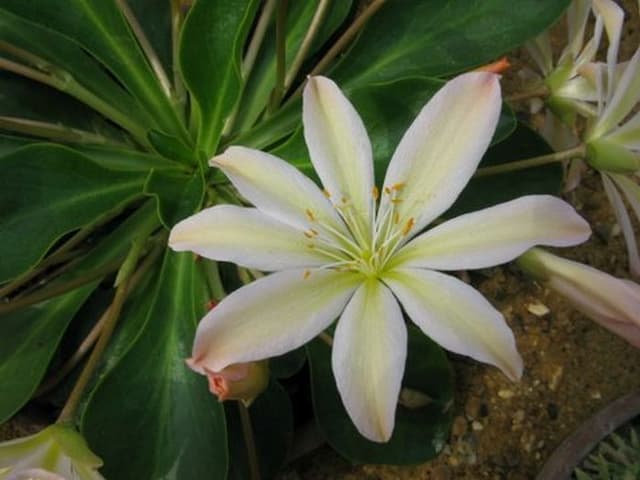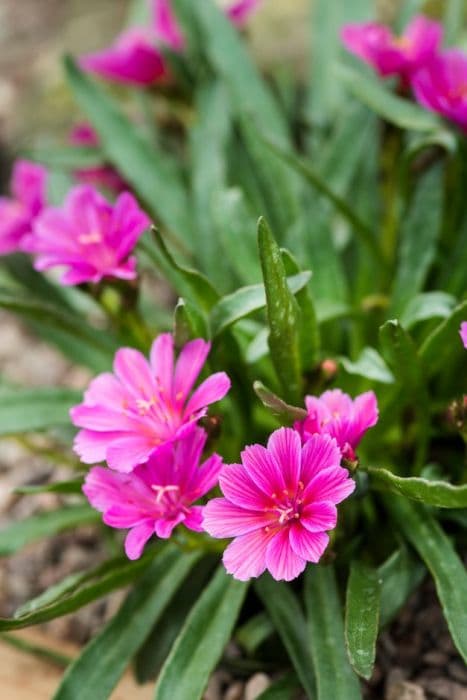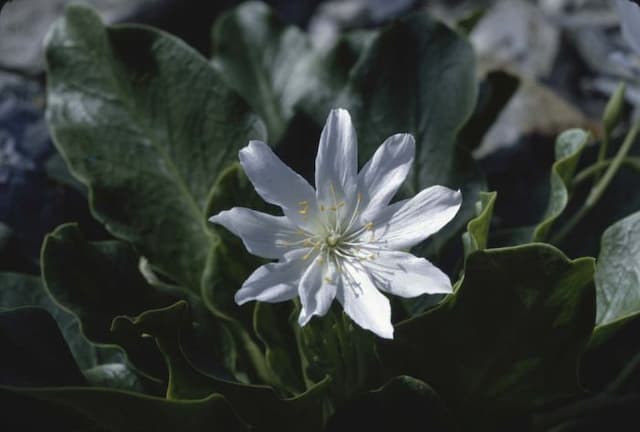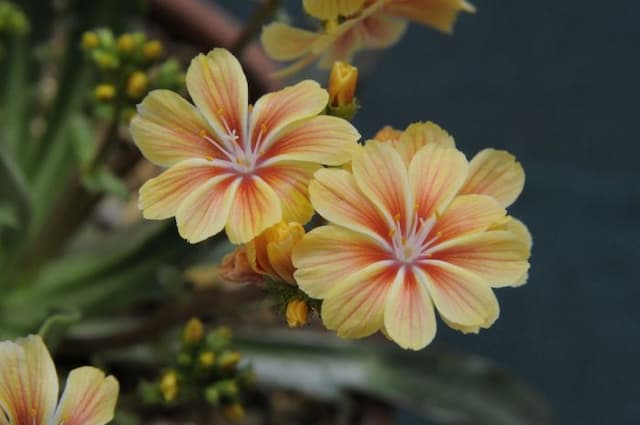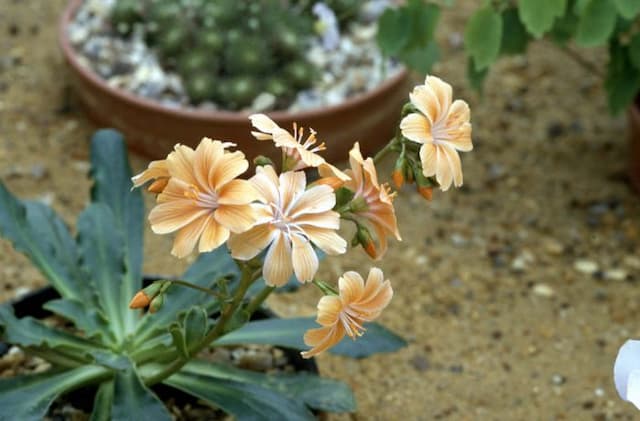Tweedy's Lewisia Lewisiopsis tweedyi 'Rosea'
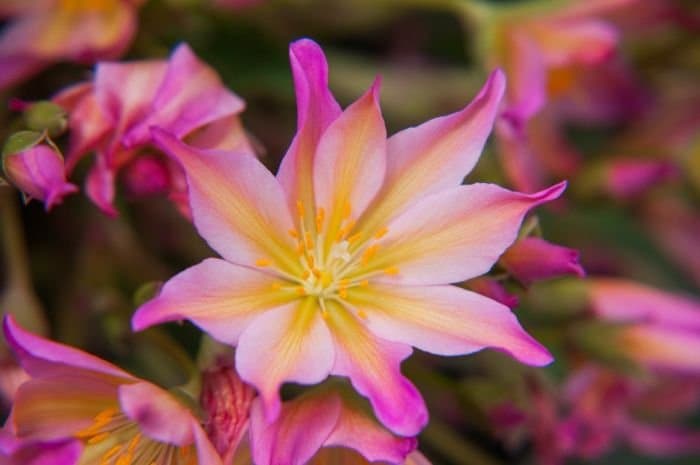
ABOUT
The plant known as 'Rosea' is characterized by its striking appearance, with large, rounded leaves that have a somewhat succulent texture, suggesting they are capable of retaining moisture. These leaves typically exhibit a lush green hue, providing a dense foliage backdrop for the flowers. The blooms emerge in a captivating shade of pink, brightening the plant with their soft, warm tones. Each flower displays a symmetrical arrangement of petals, radiating out from the center in an organized fashion that is visually pleasing. The impression given by these blossoms is one of delicate beauty, often enhanced by the subtle contrasts between their pink petals and the plant's green leaves. The overall effect is an appealing display of color and form that is both eye-catching and harmonious.
About this plant
 Names
NamesFamily
Montiaceae
Synonyms
Tweedy's Lewisia, Rosea Pink Lewisia
Common names
Lewisia tweedyi 'Rosea', Oreobroma tweedyi 'Rosea'
 Toxicity
ToxicityTo humans
The plant commonly known as Tweedy's Lewisia is not generally known to be toxic to humans. There are no well-documented adverse effects or symptoms of poisoning associated with the consumption or handling of Lewisiopsis tweedyi 'Rosea' by humans.
To pets
Tweedy's Lewisia is not commonly listed as a toxic plant to pets such as dogs and cats. There is no significant evidence to suggest that ingestion of any part of Lewisiopsis tweedyi 'Rosea' will result in poisoning or adverse health consequences in pets. However, as with any non-food plant, ingestion may potentially cause mild gastrointestinal upset due to the ingestion of non-digestible material.
 Characteristics
CharacteristicsLife cycle
Perennials
Foliage type
Deciduous
Color of leaves
Green
Flower color
Pink
Height
1-2 feet (30-61 cm)
Spread
1-2 feet (30-61 cm)
Plant type
Herb
Hardiness zones
4
Native area
North America
Benefits
 General Benefits
General Benefits- Aesthetic Appeal: Adds vibrant pink blossoms to garden settings, enhancing visual interest.
- Wildlife Attraction: Attracts pollinators including butterflies and bees, promoting biodiversity.
- Drought Tolerance: Once established, it requires minimal water, making it suitable for xeriscaping or low-water gardens.
- Easy Maintenance: Known for being low-maintenance, requiring only basic care to flourish.
- Cold Hardy: Capable of surviving in colder climates, which makes it a versatile choice for many gardens.
- Soil Adaptable: Can thrive in a variety of soil types as long as they have good drainage.
- Long Blooming: Produces flowers for an extended period, providing color in the garden throughout the growing season.
- Compact Size: Its relatively small size makes it suitable for rock gardens, containers, or small garden spaces.
 Medical Properties
Medical PropertiesThis plant is not used for medical purposes.
 Air-purifying Qualities
Air-purifying QualitiesThis plant is not specifically known for air purifying qualities.
 Other Uses
Other Uses- Lewisiopsis tweedyi 'Rosea', commonly known as Tweedy's Lewisia, can be used as a natural dye source for fabrics and art projects, where its petals provide subtle color variations.
- The plant's visually appealing foliage and flowers make it suitable for use in pressed flower crafts, such as creating bookmarks, cards, or decorative framed art.
- It serves as an educational tool in botanical studies to illustrate survival adaptations of alpine plants, with its thick, fleshy leaves that store water.
- In photography, Tweedy's Lewisia is a popular subject for macro and nature photographers due to its intricate patterns and vibrant colors.
- The plant can be utilized in rock gardens for erosion control as its roots help to stabilize loose soil on slopes.
- It can be planted in fairy gardens for a touch of realism and color, providing an attractive backdrop for the miniature settings.
- The blooms are sometimes used in artisanal crafts, including candle making, where they can be embedded into the wax for a decorative effect.
- Tweedy's Lewisia's unique appearance can be inspirational in landscape painting, offering artists a vibrant subject with distinctive textures to portray.
- When dried, the fleshy leaves can be used in creating natural potpourri mixes, contributing a pleasant appearance, though not necessarily fragrance.
- Its drought resistance makes Tweedy's Lewisia a model plant in xeriscaping education, where water conservation in gardening is emphasized.
Interesting Facts
 Feng Shui
Feng ShuiTweedy's lewisia is not used in Feng Shui practice.
 Zodiac Sign Compitability
Zodiac Sign CompitabilityTweedy's lewisia is not used in astrology practice.
 Plant Symbolism
Plant Symbolism- Rarity: Lewisiopsis tweedyi 'Rosea', commonly known as Tweedy's Lewisia, is a relatively rare and specialized plant, symbolizing uniqueness and the beauty found in scarcity.
- Resilience: This plant is known for its ability to grow in rocky, alpine environments, representing the ability to thrive in challenging conditions and symbolizing strength and endurance.
- Beauty: With its attractive rose-colored flowers, Tweedy's Lewisia signifies beauty and appreciation for the aesthetic pleasures in life.
- Adaptation: Tweedy's Lewisia has adapted to survive in specific and tough conditions, symbolizing adaptability and the vital importance of adjusting to one's environment.
 Water
WaterColumbine meadow rue (Lewisiopsis tweedyi 'Rosea') should be watered regularly to maintain evenly moist soil, especially during the growing season. Typically, this means watering deeply once a week with roughly 1 gallon of water, but this can vary depending on climate and soil conditions. It's important to reduce the frequency of watering as the plant goes dormant in the fall, and in the winter, only water if the soil becomes very dry. Always check the top inch of soil for moisture before watering to avoid overwatering. Avoid getting water on the foliage to reduce the risk of fungal diseases.
 Light
LightColumbine meadow rue thrives best in partial shade where it can receive filtered sunlight. It prefers a spot that is shielded from harsh afternoon sun, ideally receiving morning sun and afternoon shade. Locations under the canopy of tall trees that provide dappled light throughout the day are also suitable for this plant.
 Temperature
TemperatureColumbine meadow rue prefers moderate temperatures and does well in a range typically between 60 and 75 degrees Fahrenheit. It can survive minimum temperatures down to 40 degrees Fahrenheit but does not tolerate extreme heat or cold well. The ideal temperature range for its growth and flowering is from 60 to 70 degrees Fahrenheit.
 Pruning
PruningColumbine meadow rue should be pruned to remove spent flower stems and to shape the plant after the blooming period, typically in late summer or early fall. This encourages new growth and can result in a second, although less vigorous, bloom. Prune damaged or dead foliage anytime during the year to maintain plant health and appearance. It's not necessary to prune this plant heavily; light trimming is usually sufficient.
 Cleaning
CleaningAs needed
 Soil
SoilTweedy's Lewisia prefers a well-draining soil mix with a bit of sand or perlite to improve drainage. Its ideal soil pH ranges from neutral to slightly acidic, around 6.0 to 7.0. Adding a bit of organic compost to the soil mix can help provide nutrients.
 Repotting
RepottingTweedy's Lewisia generally requires repotting every 2 to 3 years, or once the plant has outgrown its current container. Spring is the ideal time for repotting to give the plant time to establish before winter.
 Humidity & Misting
Humidity & MistingTweedy's Lewisia thrives in moderate humidity levels, typical of indoor environments. It does not require high humidity and can tolerate dry air, but it should not be subjected to extremely arid conditions for prolonged periods.
 Suitable locations
Suitable locationsIndoor
Keep in well-draining soil, bright light, and moderate temperatures.
Outdoor
Plant in rocky, well-drained soil; full sun to partial shade.
Hardiness zone
4-8 USDA
 Life cycle
Life cycleTweedy's Lewisia 'Rosea,' a perennial plant, begins its life cycle when seeds are dispersed into suitable soil, typically in late spring or early summer. After germination, seedlings emerge and develop a rosette of fleshy, evergreen leaves at the ground level. As the plant matures, roots become established; the taproot allows the plant to access deep water reserves and aids in survival through dry periods. In the following spring or early summer, it produces flower stalks with pink blooms, attracting pollinators for seed production. After flowering, seeds mature and are released to restart the cycle. During winter, the plant enters dormancy, with leaves often persisting to photosynthesize on warmer days.
 Propogation
PropogationPropogation time
Spring-Early Summer
The most popular method for propagating the plant commonly known as Lewisiopsis tweedyi 'Rosea' or Tweedy's Lewisia is from seed. Seeds can be sown in late winter or early spring in cold frames or indoors. They require a well-draining, gritty compost and should be lightly covered with soil as they need light to germinate. It is important to keep the sown seeds at a temperature of around 68 to 72 degrees Fahrenheit (20 to 22 degrees Celsius). Once seedlings emerge and are large enough to handle, they can be transplanted into individual pots. They should be grown on in cooler conditions until they are established and can be planted out after the last frost.
